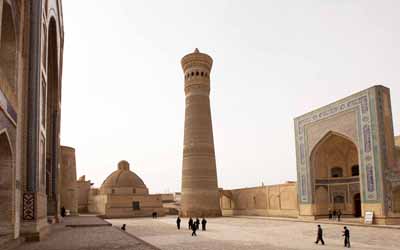Uzbekistan | Bukhara | Kalon Mosque
The first big mosque in Bukhara was constructed in 713 within the walls of the Citadel. In 770 a new congregational mosque with accompanying minaret was built outside the Citadel, apparently on the site of the current Kalon Mosque. From the eighth to the eleventh centuries the mosques on this site was repeatedly damaged or destroyed by earthquakes and fires and subsequently rebuilt and enlarged. In 1121-22, during the rule of the Qarakhanids, a still larger mosque and minaret was built on the same location using wood from the previous structure. The minaret soon collapsed, seriously damaged the mosque. In 1127 the mosque was rebuilt yet again, along with the accompanying 153-foot high Kalon Minaret.
In the year 1220, on the 10th, or the 16th of February, depending on whose account we believe, the hitherto noble city of Bukhara Fell To Chingis Khan and his army. He and his son Tolui rode their horses into the big Friday Mosque on the site of the current Kalon Mosque, where Tolui dismounted and ascended the minbar, or pulpit. According to the Persian historian Juvaini, Chingis then asked if this was the palace of the Khorezmshah: he was informed by the imams in attendance that it was not the palace of an earthly ruler but the House of God. He too then dismounted and climbed up onto the pulpit. Although it may have been the House of God, he had more earthly concerns. The Mongols’ horses were hungry and must be fed, he ordered from the pulpit. The city’s granaries were opened and the grain dispensed for horse feed. Chingis’s men dragged the cases which were used to store Qurans out of the mosque, dumped out the sacred books, and used them as feeding troughs for their horses. Their horses having been seen to, they ordered up wine and dancing girls for their own entertainment. Soon the mosque rang with the sound of Mongol songs bellowed by the celebrating inebriates.
Juvaini, although a scribe in pay of one of Chingis’s descendants, was a Sunni Muslim himself, and he could not keep a note of disapproval out his account of these carryings-on. Hitherto dignified imams, sheiks, and sayyids, he tells us, were made to look after the Mongol horses while their owners partied. When the bacchanalia was over the Mongols rode away, trampling under the feet of their horses the leaves of the Qurans which had been scattered around the courtyard of the mosque. At this point, an imam named Jalal-al-Din Ali b. al-Hasan Zaidi, “chief and leader of the sayyids of Transoxiania . . . famous for his piety and asceticism,” turned to an imam named Rukn-ad-Din Imamzada, “one of the most excellent savants in the the world,” and lamented, “ . . . what state is this? That which I see do I see it in wakefulness or in sleep, O Lord?” Apparently all of which he had just seen seemed like a nightmare to him. His companion replied, “Be silent: it is the wind of God’s omnipotence that bloweth, and we have no power to speak.”
The mosque was totally destroyed in the fires that followed the Mongol sack of the city. It is not clear when a mosque was first rebuilt on the site. In 1539, under the Shaybanids (r. 1500–98), whatever structure did exist was replaced by a completely new mosque with 289 vaulted bays. This is the version of the mosque which has survived down to the present.
The Kalon Minaret, center, survived the sack of the city by the Mongols and can be seen to this day. On the right is the entrance to the current Kalon Mosque. On the left is the front of the Mir-i-Arab Madrassa.
Front of the Kalon Mosque
Another view of the front of the Kalon Mosque
Entrance to the Kalon Mosque
Courtyard of the Kalon Mosque. It can reportedly hold 10,000 people.
Courtyard of the Kalon Mosque
Courtyard looking the other way (Enlargement for a mes)
The Courtyard
Courtyard of the Kalon Mosque
Current Minbar (pulpit) in the mosque, obviously not the one mounted by Chingis Khan and his son Tolui.
Vaulted bays on either side of the Courtyard
Vaulted bays on either side of the Courtyard (Enlargement for a mes)
Vaulted bays on either side of the Courtyard
Graybeard fingering his beads in the courtyard
Dome of the Kalon Mosque
Bukharan Skyline, with the Kalon Mosque on the right


















